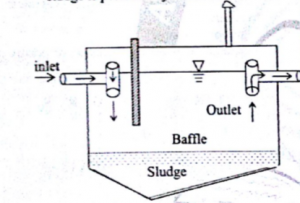Septic Tank- Design Criteria and Methods of Disposal
Septic tank is provided in areas where sewers have not been laid and for isolated communities, schools, hospitals, other public institutions, etc. Here we are going to discuss the septic tank design criteria and methods of disposal in the septic tank.
Septic tank is a sedimentation tank with longer detention time, that is 12 to 36 hours. Both sedimentation and sludge digestion takes place in this tank.
Effluents should be disposed off either for subsurface irrigation or in cesspools or soak pits or treated inlet in trickling filter before disposed off in watercourse. Sludge collected at the bottom gets digested anaerobically. The digested sludge is periodically removed.

Design Criteria of the septic tank
1. Capacity of tank
The capacity of the tank is the sewage stored in detention time+ volume of sludge stored during a period of cleaning
Sludge: 30 litre /person/year
Period of clearing 6 months to 3 years ( generally 1 year)
Detention tank: 12 to 36 hours ( generally 24 hours)
Disposal of effluents from the septic tank
The effluent of the septic tank will have BOD of 100 to 200 mg/l and hence it can not be disposed of into watercourses.
Methods of septic tank effluent disposal
a) Absorption trenches
The suspended organic matter present in the effluent will be absorbed in the absorption trench filled with gravel.

b) Soak pit

The effluent is allowed to be soaked or absorbed into the surrounding soil. The pit is filled with gravel brickbats etc..
c) Cess Pool

The top portion acts as absorption trench and bottom portion acts as a septic tank used when the subsoil is porous and when there is no well nearby.
Hope you liked Septic Tank- Design Criteria and Methods of Disposal. If you have any doubt please free to ask me.